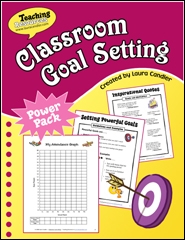Goal Setting 101: Understanding the Process
 Often it's the non-academic curriculum that's most helpful in preparing
students for life. Reading and math are important, but organizational
skills, social skills, and a knack for finding information on the
Internet can lead to big payoffs as well. One area we often overlook,
however, is teaching our students how to set goals and create action
plans for themselves. Many of us never were taught how to set goals for
ourselves, and we only discovered the power of goal-setting later in
life. But with a little creativity, we can adapt the strategies used by
successful adults and share them with our students.
Often it's the non-academic curriculum that's most helpful in preparing
students for life. Reading and math are important, but organizational
skills, social skills, and a knack for finding information on the
Internet can lead to big payoffs as well. One area we often overlook,
however, is teaching our students how to set goals and create action
plans for themselves. Many of us never were taught how to set goals for
ourselves, and we only discovered the power of goal-setting later in
life. But with a little creativity, we can adapt the strategies used by
successful adults and share them with our students.THE POWER OF BELIEF
|
|
So, how can we encourage our students to embrace a future full of unlimited possibilities? Start by showing them how others have overcome obstacles and achieved their goals. Seek out inspirational stories of people who are important to your students, and share those stories with them. Biographies often detail the amazing accomplishments of great people, but a biography of Thomas Edison might not be the best way to inspire today's generation. You'll find newspapers and magazines to be equally rich sources of inspirational stories.
The Olympics provided the perfect opportunity to highlight stories of athletes who have come from humble backgrounds and risen to greatness. How about success stories of singers or movie stars? Seventeen magazine recently featured an inspirational interview with pop singer Taylor Swift, in which she described how she wrote out a very specific set of personal goals long before she became a star. Those stories are everywhere when you start looking for them. Books like Chicken Soup for the Childrens Soul (or Chicken Soup for the Teenage Soul) are filled with short inspirational stories that demonstrate the power of belief in oneself and one's abilities. Challenge your students to seek out and share such stories with the class.
|
|
INTRODUCTION TO GOAL SETTING
When you feel your students are ready to start setting goals for themselves, introduce them to the goal-setting process. First, make sure they know what a goal is by asking students to volunteer goals they or their friends have set for themselves in the past. List their ideas on the board, and discuss the difference between long-term and short-term goals. Short-term goals might include reading a difficult book, earning a perfect score on a spelling test, or arriving at school on time each day for a month. Long-term goals could include goals for the school year, earning a scholarship to college, or dreams about future careers.Then tell your students that many successful athletes, singers, writers, and business people have discovered a method for achieving their goals, and it's so easy that your students can learn those goal-setting secrets themselves. Display a poster or chart of the Secrets of Goal Setting while you review the steps with your students.
Secrets of Goal Setting
- Write clear and measurable goals.
- Create a specific action plan for each goal.
- Read your goals daily and visualize yourself accomplishing them.
- Reflect on your progress to see if you are on target.
- Revise your action plans if needed.
- Celebrate your accomplishments.
0 comments:
Post a Comment